We were in London for 12 days.
- Piccadilly Circus [Square]: This is London’s Times Square, and I liked it only marginally more than the NYC one – and only because it’s smaller. Nothing exciting to see here. (Also, don’t expect animals or tightropes: in British English, a circus is just ‘an open circular place where several streets intersect.’)
- Trafalgar Square [Square]:
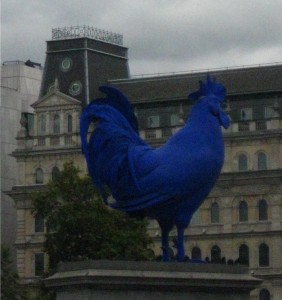 The best part about this part of London is that they periodically hold festivals here. Last time I was here (ten years ago!), they had an Indian festival (maybe Holi?), and there was a Malaysian festival happening this time. In essence, it’s just a square, in a traffic-busy part of the city. There are plinths (platforms) at the back, which host regular art installations. At present, there is a ridiculously-bright cerulean rooster on one. The internet claims that it represents the defeat of France, but I think the artist secretly wanted to be known for putting a blue cock in the center of London. There are also some street artists at the back, in front of the National Gallery, and I heard that they have to audition to even get a spot in such a prominent place. If there is a food festival here, it may be worth visiting; otherwise, only come to see the museums around it, or you will be sorely disappointed.
The best part about this part of London is that they periodically hold festivals here. Last time I was here (ten years ago!), they had an Indian festival (maybe Holi?), and there was a Malaysian festival happening this time. In essence, it’s just a square, in a traffic-busy part of the city. There are plinths (platforms) at the back, which host regular art installations. At present, there is a ridiculously-bright cerulean rooster on one. The internet claims that it represents the defeat of France, but I think the artist secretly wanted to be known for putting a blue cock in the center of London. There are also some street artists at the back, in front of the National Gallery, and I heard that they have to audition to even get a spot in such a prominent place. If there is a food festival here, it may be worth visiting; otherwise, only come to see the museums around it, or you will be sorely disappointed. - Tower Bridge [View]:
 I didn’t go to the bridge exhibit, as it was incredibly crowded and kind of expensive. But, the bridge looks cool from the side. I would have thought this would be called London Bridge, but in fact, London Bridge is a completely undecorated, boring bridge a few down from this one. While we were there, they closed this bridge for a few minutes only: just long enough to shoot a scene of a car driving down the bridge. B’s mom says she saw it on Amazing Race later, so there you have it.
I didn’t go to the bridge exhibit, as it was incredibly crowded and kind of expensive. But, the bridge looks cool from the side. I would have thought this would be called London Bridge, but in fact, London Bridge is a completely undecorated, boring bridge a few down from this one. While we were there, they closed this bridge for a few minutes only: just long enough to shoot a scene of a car driving down the bridge. B’s mom says she saw it on Amazing Race later, so there you have it. - Emirates Air Line [View]: This is like the London Eye, except newer, cheaper, and it actually goes somewhere. Okay, to be fair, it’s on the far East End of the city, meaning that the view
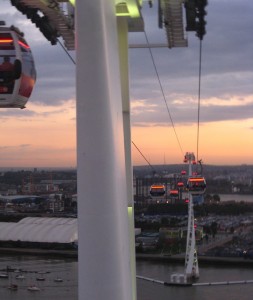 is of a different part of London. However, the cable cars are fun to ride and long enough to appreciate the view. They also play some kind of promotional video inside, about the East End’s contribution to British commerce. I wouldn’t call this a must-do, but if you find yourself at loose ends – especially around sunset or sunrise, this is a nice option.
is of a different part of London. However, the cable cars are fun to ride and long enough to appreciate the view. They also play some kind of promotional video inside, about the East End’s contribution to British commerce. I wouldn’t call this a must-do, but if you find yourself at loose ends – especially around sunset or sunrise, this is a nice option. - Monument to the Fire of London [View]: This is a giant lighthouse-style building in the middle of the city, serving as a memorial to the fire that wiped out much of London in the 1600s. You can climb the 300-some steps to the viewing platform at the top for much less money than most other ‘view’ attractions in the city. You can take your time, but it is narrow in there, much like the Florence campanile steps. The view is worthwhile, and they even give you a piece of paper commemorating your climbing prowess when you get back down.
- Royal Observatory of Greenwich
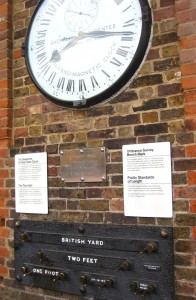 [Museum, View]: We never actually went inside, so this is only a partial review. However, even given that, I thought that this place was more than worth it. It’s located on a hill within Greenwich Park, which has wonderful views of the city, the park, and the Naval College area. It has a fairly isolated park in the back, with lots of industrious squirrels and a few picnic tables. Out front, there is the line between the Eastern and Western Hemispheres, which is a decent photo op. Right next to it is the official clock and the official weights and measures instituted hundreds of years ago. And we heard the inside of the observatory is cool too.
[Museum, View]: We never actually went inside, so this is only a partial review. However, even given that, I thought that this place was more than worth it. It’s located on a hill within Greenwich Park, which has wonderful views of the city, the park, and the Naval College area. It has a fairly isolated park in the back, with lots of industrious squirrels and a few picnic tables. Out front, there is the line between the Eastern and Western Hemispheres, which is a decent photo op. Right next to it is the official clock and the official weights and measures instituted hundreds of years ago. And we heard the inside of the observatory is cool too. - Old Royal Naval College [Museum, Church]: This turns out to be less of a college and more like the ‘L’Hôtel des Invalides’ in Paris: it seems to have been intended to house British veterans after their service. The visitor’s center has some interesting facts about ‘a day in the life,’ including a fun game they played (‘monkey’ something), in which a veteran on a wooden leg spun around trying to mark others with chalk;
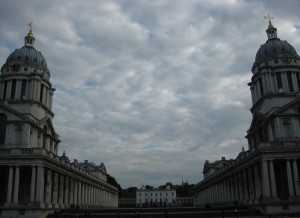 if he succeeded, they switched places. Perhaps this seemed like a fun game because each veteran’s daily beer allowance was four pints! Also interesting was the design of the ‘Painted Hall’ in the complex, which had giant ceiling murals depicting kings and gods. It was more intricate and beautiful than much of what we saw in Kensington Palace and the like. The church was nice too, and the view of the water and of the Naval College buildings themselves quite lovely. The structure was built by meticulous architect Christopher Wren, who also designed St. Paul’s cathedral. He wanted a more grand structure, which more closely resembled the Paris ‘Hotel,’ but the monarch at the time (Queen Anne) did not want that. She wanted a gap in the complex just large enough for her little white house to still have an unobstructed view of the Thames. Despite dying before building began, Queen Anne still ended up getting her way. Poor, thwarted Wren.
if he succeeded, they switched places. Perhaps this seemed like a fun game because each veteran’s daily beer allowance was four pints! Also interesting was the design of the ‘Painted Hall’ in the complex, which had giant ceiling murals depicting kings and gods. It was more intricate and beautiful than much of what we saw in Kensington Palace and the like. The church was nice too, and the view of the water and of the Naval College buildings themselves quite lovely. The structure was built by meticulous architect Christopher Wren, who also designed St. Paul’s cathedral. He wanted a more grand structure, which more closely resembled the Paris ‘Hotel,’ but the monarch at the time (Queen Anne) did not want that. She wanted a gap in the complex just large enough for her little white house to still have an unobstructed view of the Thames. Despite dying before building began, Queen Anne still ended up getting her way. Poor, thwarted Wren. - Tate Modern [Museum]: Ah, modern art museums. I want to like you, I really do. And the first floor of this one, which primarily had art from the 1930s through 60s, was interesting enough. Dali, Braque, Picasso, and others I didn’t know, all playing with twisting and turning objects to tell a story. But then, the next floor was all about color and shapes – both of which I like – but to the exclusion of subjects. In other words, you can make a droopy, melting clock, and it still says something to me about time; if you make a blue square, all I personally see is a blue square. I mean, Picasso used blue squares too, but he put them together to simulate humans doing something, so it was a story to me. What’s the story with a square within a square within a square? I remember being fascinated by the series when I first saw it in Paris ten years ago: I could do that. However, it’s not just about that, because it’s also about thinking to do that, and most people don’t. But explain to me the originality of thinking to put a mirror in a museum. I’m talking the flimsy kind you buy for your dorm room in Ikea. One of these was on the top floor, and the description was all fluffy prose about discovering yourself and being part of the art. I kept walking around it, thinking that it must have some weird distortion or some strange border or dimensions. Not so. Sorry to be so plebeian, but I just don’t get it. Where is the talent or the originality or the thought-provoking part of that? Why would a museum pay a guy thousands of dollars to go to Ikea? Alas, I am hopelessly déclassé.
- Tate Britain [Museum]:
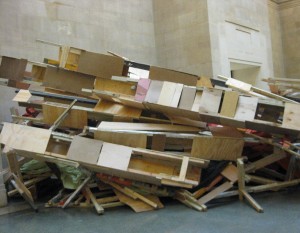 When I first approached this museum, I discovered a giant line winding around two big blocks! I was going to skip going, because at the rate that it was (not) moving, I would get to the front exactly when the museum closed. However, I happily realized that the queue was for something at the University of the Arts, not at the museum. This museum also has modern/contemporary art to baffle me, but its collection started much earlier. I learned a lot about British art, and actually discovered a few pieces I liked. (Not the giant ‘pier’ construction that resembled a junk heap on the side of the road in Ohio; sorry, artist, I am not smart enough to understand your vision.) Fairly worthwhile, I thought, but not at the very top of my list.
When I first approached this museum, I discovered a giant line winding around two big blocks! I was going to skip going, because at the rate that it was (not) moving, I would get to the front exactly when the museum closed. However, I happily realized that the queue was for something at the University of the Arts, not at the museum. This museum also has modern/contemporary art to baffle me, but its collection started much earlier. I learned a lot about British art, and actually discovered a few pieces I liked. (Not the giant ‘pier’ construction that resembled a junk heap on the side of the road in Ohio; sorry, artist, I am not smart enough to understand your vision.) Fairly worthwhile, I thought, but not at the very top of my list. - National Portrait Gallery [Museum]: If I’m being entirely honest, I’d say I’m not a big fan of portraits. How different can people’s busts look on canvas? Also, it’s hard to evaluate how much of a portrait is reality, versus wishful thinking or post-facto editing based on the style of the times. And I find the choice of subject somewhat insulting: in the 12th-19th centuries, it was based on wealth; in the 20th-21st, it has been based on power and celebrity. (Those who would argue that they are the same thing can look at the account books of Mother Teresa or Screech from Saved by the Bell.) That said, I was pleasantly surprised. The modern portraits were particularly interesting because of the diversity of styles. One man even made a 3D rendering of his head out of his own blood; he makes a new one every five years. (Does blood start to smell after that amount of time?) On a less Silence of the Lambs note, there were a few that particularly embodied the person pictured: a children’s book author portrayed with colorful lights and toys which lent the portrait a sense of whimsy – or a diplomat pictured with strong pencil lines that gave him a sort of gravitas. There was also a Tudor exhibit, which was interesting. Since museums are free in London, I would recommend popping in to see what you can see, even if you only have 15 minutes.
- Kensington Palace [Museum]: Definitely on the expensive side, but interesting nonetheless. The palace is divided into five ‘paths,’ each charting a different inhabitant. First, we explored the life of Great Britain’s longest-reigning monarch, Victoria. Her mother kept her fairly isolated as a child, so when she took the throne at 18, few expected the level of composure and social skills she exhibited. Not long after her ascension, she met and married Prince Albert: she was much enamored of him. She was a strong ruler, and he made his own niche as well, organizing the great world fair exhibition. Nine children and less than two decades later, Albert caught a disease and died. Grief-stricken Victoria spent the next three decades mourning rather than doing much ruling; the people seem to have eventually forgiven her for this.
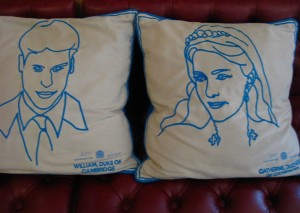 Another path in the palace showed off the fashions of the 60s, 70s, 80s, and 90s – from Princess Margaret (the Queen’s sister) through Princess Diana. The biggest surprise for me was how many of the designs weren’t just traditional and dignified, but also almost dowdy: they made the women look much older than their years. There was exactly one dress of the bunch that I would have considered wearing: a dark blue, strapless fancy crinoline-style gown with silver stars on it. It made me appreciate the current Duchess of Cambridge’s style more: she’s certainly covered up and traditional, but she at least looks young and female. On the way to the fashion exhibit, we ran into a visual timeline of the monarchy, along a wall of the palace, with benches beneath. On the benches were pillows, with a monarch’s outline sewn into each. I can’t compare this to Buckingham Palace, but I enjoyed the variety of exhibits – all with detailed descriptions, and found it wasn’t too crowded.
Another path in the palace showed off the fashions of the 60s, 70s, 80s, and 90s – from Princess Margaret (the Queen’s sister) through Princess Diana. The biggest surprise for me was how many of the designs weren’t just traditional and dignified, but also almost dowdy: they made the women look much older than their years. There was exactly one dress of the bunch that I would have considered wearing: a dark blue, strapless fancy crinoline-style gown with silver stars on it. It made me appreciate the current Duchess of Cambridge’s style more: she’s certainly covered up and traditional, but she at least looks young and female. On the way to the fashion exhibit, we ran into a visual timeline of the monarchy, along a wall of the palace, with benches beneath. On the benches were pillows, with a monarch’s outline sewn into each. I can’t compare this to Buckingham Palace, but I enjoyed the variety of exhibits – all with detailed descriptions, and found it wasn’t too crowded. - Hyde Park/Kensington Gardens [Park]:
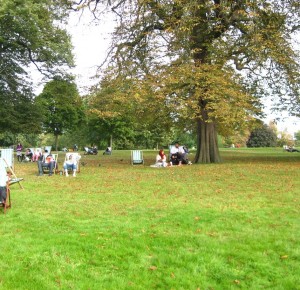 This is a large park. It has two different names: the east side is Hyde Park, and the west is Kensington Gardens. I imagine that this is because Hyde Park was a publicly-used spaced just at the outskirts of the city, while Kensington Palace was purchased by one of the royals when it was still outside the city, so he could escape from the allergies triggered by the city center. The only difference I observed was a preponderance of statues and memorials on the royalty side. As in romance novel times, they still have horseback riding in the park, but the rest is mostly relaxing on the grass, soccer games, walking dogs, picnics, and getting way too close to angry-looking swans and ducks.
This is a large park. It has two different names: the east side is Hyde Park, and the west is Kensington Gardens. I imagine that this is because Hyde Park was a publicly-used spaced just at the outskirts of the city, while Kensington Palace was purchased by one of the royals when it was still outside the city, so he could escape from the allergies triggered by the city center. The only difference I observed was a preponderance of statues and memorials on the royalty side. As in romance novel times, they still have horseback riding in the park, but the rest is mostly relaxing on the grass, soccer games, walking dogs, picnics, and getting way too close to angry-looking swans and ducks. - Vauxhall Pleasure Gardens [Park]: These gardens were famous in my romance books, as a place for chaperone-not-approved assignations under the cover of respectability. They held regular masked entertainments there, with dancing and clowns, within this almost-forest. Today, the gardens/park have been reconstructed for historical and touristic purposes. The owners went bankrupt in the 1840s; perhaps due to the loosening of morality restrictions on debutantes? So, they converted it into something slum-like for a hundred years, before re-building it, presumably to cash in on some tourist dollars or to give some green space to this part of the city – or both. Now, the park space is small: it has a few fields, a few basketball/tennis courts, and a quaint tea house. You can safely skip it as a tourist attraction, if you’re short on time.
- St. James’s Park [Park]: This is a nice park near Westminster, with a lake, lots of ducks and geese, and a beer garden. Their non-beer selection is a bit limited, but it’s a nice view. There’s also an interesting exhibit on one of the greens describing WWI, from disease to punishment. Fun times.
- Cleopatra’s Needle [Monument]: The story of this giant obelisk is more interesting than the obelisk itself. However, the boys posed for a nice photo with one of the sphinxes beside the structure, which was fun enough. And it’s near a fun park.
- Brick Lane Market / Up Sunday Market / Old Spitalfields Market [Market]: I loved these markets, all next to each other in a row. The first one had lots of thrift finds, from vintage clothes to American cereals. My sister bought a cheap DVD, and B got himself a pair of well-fitting jeans. The next part of the market is largely food vendors, but of almost every cuisine imaginable. From juice bars or vegan Moroccan to Chinese-style chicken or Thai yellow curry, you won’t go hungry no matter how picky. Also in the market were vendors of ‘hipster’-style crafts, from screen t-shirts with cute sayings to leather wallets and purses. But there was also a guy who had set up a chair for giving hair cuts and a vendor specializing in random shoes. Also interesting: I heard more French here than I have in many places in France, so I assume the hipster French contingent has infiltrated the neighborhood. This was one of my favorite things to do in London; I even managed to go both Sundays we were in the city!
- Borough Market [Market]:
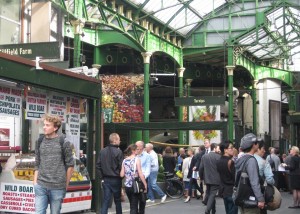 This market has all of the food available in the world. I mean, some of it isn’t exactly affordable, but there are plenty of samples for those of us whose pocketbooks can’t handle the price tags. There are vendors who make ready-to-eat food, from pork to cookies, and there are produce vendors and butchers too. Their collection of berries and fruit looked so fresh that I would have bought the whole stand, if the price hadn’t been in the league of Beyonce’s salary. Even their mushroom selection was incredibly extensive and delicious-looking! I could spend hours watching people and produce come and go. And then I’d have to go somewhere else to actually eat.
This market has all of the food available in the world. I mean, some of it isn’t exactly affordable, but there are plenty of samples for those of us whose pocketbooks can’t handle the price tags. There are vendors who make ready-to-eat food, from pork to cookies, and there are produce vendors and butchers too. Their collection of berries and fruit looked so fresh that I would have bought the whole stand, if the price hadn’t been in the league of Beyonce’s salary. Even their mushroom selection was incredibly extensive and delicious-looking! I could spend hours watching people and produce come and go. And then I’d have to go somewhere else to actually eat. - Covent Garden [Market]:
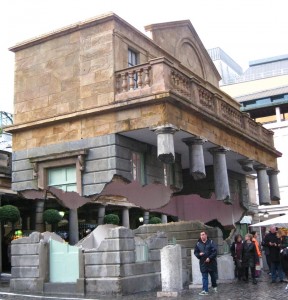 This is a kind of market with souvenir stands all about. One side features carts selling ‘Hangover’ hoodies and ‘I <3 London’ mugs, while another has more artisanal goods, like patterned scarves and beaded earrings. One level out from that are some more traditional(ly overpriced) stores, from the Apple store to Luis Vuitton. Inside the very core of the complex is enough space for a performing artist or two: we heard a violin performance and an operatic soloist in the times we were there. In the evening, we watched a fairly bad and drawn out Houdini-style performance on one side of the market, below the Punch and Judy pub. On our last day, we saw an interesting art installation here: a destroyed house that seemed to be holding itself up with air. Despite its famous name, I would skip this place unless you’re in the area or have the time.
This is a kind of market with souvenir stands all about. One side features carts selling ‘Hangover’ hoodies and ‘I <3 London’ mugs, while another has more artisanal goods, like patterned scarves and beaded earrings. One level out from that are some more traditional(ly overpriced) stores, from the Apple store to Luis Vuitton. Inside the very core of the complex is enough space for a performing artist or two: we heard a violin performance and an operatic soloist in the times we were there. In the evening, we watched a fairly bad and drawn out Houdini-style performance on one side of the market, below the Punch and Judy pub. On our last day, we saw an interesting art installation here: a destroyed house that seemed to be holding itself up with air. Despite its famous name, I would skip this place unless you’re in the area or have the time. - St. Paul’s Cathedral [Church]:
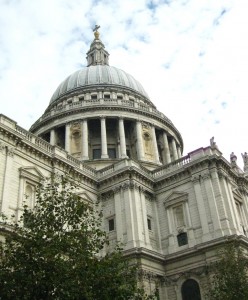 This is a pretty church, with a nice garden, right in the center of the city. The inside has a cool altar and a variety of interesting decorations. I most liked the white sculpture-looking things attached to the inside walls where the pews are: they look like geometric modern art. The church also has a whispering gallery, where quiet sounds travel 30-some feet easily. We couldn’t test it out because services were in progress when we went inside. Everyone was made to feel welcome, and the acoustics were great.
This is a pretty church, with a nice garden, right in the center of the city. The inside has a cool altar and a variety of interesting decorations. I most liked the white sculpture-looking things attached to the inside walls where the pews are: they look like geometric modern art. The church also has a whispering gallery, where quiet sounds travel 30-some feet easily. We couldn’t test it out because services were in progress when we went inside. Everyone was made to feel welcome, and the acoustics were great. - Westminster Abbey [Church]: In some ways, this is like the Santa Croce in Florence: home to lots of tombs and memorial plaques for notable people. However, it also houses the burial plots and monuments of the royals and serves as their christening, marriage, and coronation grounds – so its profile is just a tad higher. Included in the fairly-astronomical price tag is an at-your-own-pace audio guide, so you can wander as you wish.
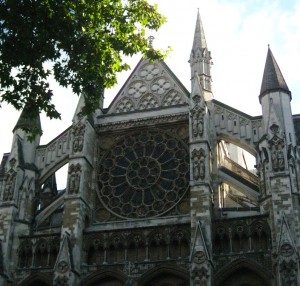 Famous people like Newton, Handel, and Darwin are buried here, as is the unknown soldier who represents all men who gave their lives for Queen and country. I actually find that quite moving, because the inscription explicitly says that no matter their names or stations, these men have earned their places beside kings for their bravery. (By the by, I believe the plaque only mentions WWI, so not sure if the British consider it more important than WWII. If it had been a case of them being made before the second war happened, I presume it would have been dedicated to the ‘Great World War’ instead.) Anyway, lots to see here, from the various chapels to the Poets’ (really, Artists’) corner of memorials to the cloisters or garden. If you like churches, this is worth it. If not, I’m not so sure.
Famous people like Newton, Handel, and Darwin are buried here, as is the unknown soldier who represents all men who gave their lives for Queen and country. I actually find that quite moving, because the inscription explicitly says that no matter their names or stations, these men have earned their places beside kings for their bravery. (By the by, I believe the plaque only mentions WWI, so not sure if the British consider it more important than WWII. If it had been a case of them being made before the second war happened, I presume it would have been dedicated to the ‘Great World War’ instead.) Anyway, lots to see here, from the various chapels to the Poets’ (really, Artists’) corner of memorials to the cloisters or garden. If you like churches, this is worth it. If not, I’m not so sure. - London Dungeon [Attraction]: This attraction’s description alluded to a historically-accurate recreation of London’s seediest moments. I suppose that technically, this is true, but if I were describing it, I would have called it a kitschy haunted house walk and ride, with some historical details thrown in. There are two primary rides: one water log-type ride, with a few splashes, but no real up-and-down; and a fairly mild vertical drop ride. The rest is trudging from room to room, with hidden things that jump out at you and an optical illusion mirror path. B found a few of the historical details interesting, but I have clearly read too many romance novels to be impressed. The two things I was impressed by:
- They do some very smart things: for example, the lines to buy tickets and to get in are both very winding and both indoors, making it unclear how long the wait will be.
- They take photos on the free-fall ride, just as the seats start to plummet – for purchase, of course. In B’s photo, he looks a bit nervous and a bit excited. In my photo, I am making a face not unlike Grumpy Cat: curmudgeonly, frowning, as if I’m about to shake my finger at someone. And that, my friends, is our personalities in a nutshell, apparently.
- Theatreland [Theatre]: We saw a theatre show, on London’s version of Broadway (or vise versa, since London likely came first). The show was Agatha Christie’s Mousetrap (or 3 Blind Mice), which is the longest-continuously-running play in London. I won’t ruin the ending, but I will comment on Agatha Christie’s works as a whole: they don’t follow the Chekhov rule, and it bugs me. Anton Chekhov (Russian playwright and all-around depressing guy) is reported to have said that if there is a gun on the wall in Act 1, you can bet it will be going off in Act 3. In other words, once you know the ending, you can see all the parts leading up to it; put another way, foreshadowing is important. In Christie’s works, I never see that. After learning the ‘answer’/murderer, I can’t work backwards to find the clues, because there are none. I think that people enjoy mysteries because they like trying to solve them; it’s why Sherlock Holmes is so popular. If only you had paid enough attention, they say, you could be this amazing too. But Christie throws all that out the window. You may as well just guess random solutions, she’s basically saying, because the clues you need to solve the mystery are off-stage. Gripes about the playwright aside, the theatre was pretty nice. We had a decent view, even having bought the second-cheapest tickets, and they had only mildly-overpriced Pringles and jelly babies for sale. And don’t feel bad if you’re not dressed up. I wouldn’t dream of going to a show in NYC in jeans, but my only dress in London was a floaty summer thing, not worth the millimeter-thin fabric it was made out of; and yet, no one batted an eyelash at my casual attire.
What We Skipped:
- Kew Gardens [Park]: This is pretty far away, and it costs $23 each!? Since when does an outing to a park or garden cost almost $50 for two people?
- Hampstead Heath [Park]: Pretty much just a park, and in the farther suburbs from town. Some of my romance novels describe it as a way stop on the way to Gretna Green (for kidnapping-style elopements), though the history online describes it more like a park for rich people who wanted to get away from the city. I can imagine it being the former at night and the latter during the day.
- Windsor Castle [Museum]: We’re apparently lazy, because this castle is farther outside of town. It looks much like a few castles we saw in Ireland – just bigger. We looked at some photos online, in case that counts!
- National Gallery [Museum]: While Van Gogh’s sunflowers was appealing, we had to prioritize, since there are so many museums in London.
- British Museum [Museum]: Ditto the above.
- Victoria and Albert Museum [Museum]: There are a lot of museums in London.
- Clink Prison Museum [Museum]: This seemed cool: the oldest prison in England – and one about which I’ve read extensively. (Who says romance novels can’t be educational?) Alas, not enough time.
- Imperial War Museum [Museum]: This is supposed to be an interesting museum about the various wars in which the UK participated. I was just having trouble summoning the energy to go somewhere so depressing. Too many terror museums: humans are kind of awful.
- Wellcome Collection [Museum]: I really wanted to get to this museum of medical curiosities, but it was a bit out of the way, and we were a bit too tired. It even stays open until 8 pm on Thursday nights, so when all other non-food-or-alcohol attractions close, you can check it out.
- London Eye [View]:
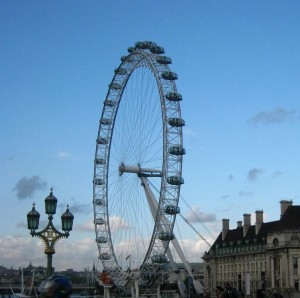 This huge ferris wheel can only barely be called that, since each ‘car’ is like a large mini room enclosed in glass. I suspect that it looks cooler from below than from atop it, and I wasn’t willing to pay more than $60 (for the two of us) to find out. Plus, given its location and height, its views would likely have been similar to the ones from the Monument to the Great Fire of London.
This huge ferris wheel can only barely be called that, since each ‘car’ is like a large mini room enclosed in glass. I suspect that it looks cooler from below than from atop it, and I wasn’t willing to pay more than $60 (for the two of us) to find out. Plus, given its location and height, its views would likely have been similar to the ones from the Monument to the Great Fire of London. - The Shard [View]: Ditto everything for the London Eye, except the moving glass ‘rooms’ – and even more expensive.
- Granary Square [View]: This is just a square with some cute fountains, some of which seem to light up. I think we got our fill in Warsaw, Budapest, and Belfast – at least for now.
- Buckingham Palace [Museum]: We saw the changing of the guard in Budapest and at the Horse Guards station: much less crowded. And I figure that Kensington Palace was more important, since royalty actually still lives there.
- Tower of London [Museum]:
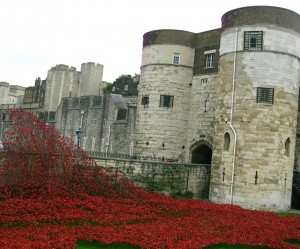 I really wanted to go here too, but there wasn’t enough time. We did see the outside though, along with the 888,246 ceramic red poppies around it, symbolizing Great Britain’s WWI casualties.
I really wanted to go here too, but there wasn’t enough time. We did see the outside though, along with the 888,246 ceramic red poppies around it, symbolizing Great Britain’s WWI casualties. - Sotheby’s [Market]: It would have been nice to see something auctioned off, but perhaps we’ll go in New York someday.
- Portobello Road [Market]: We ran out of time, sadly. (Also, B is not a big fan of antiques.)
- Columbia Road Flowers [Market]: I’m not really into flowers. (I know, the horrors.) It makes me sad that they’re dead! I prefer arboretums and such.



Pingback: Too Much Information About Our Underwear | Novelty Buffs
Pingback: Memorable Moments in London - Novelty Buffs
Pingback: What We Saw in Singapore - Novelty Buffs